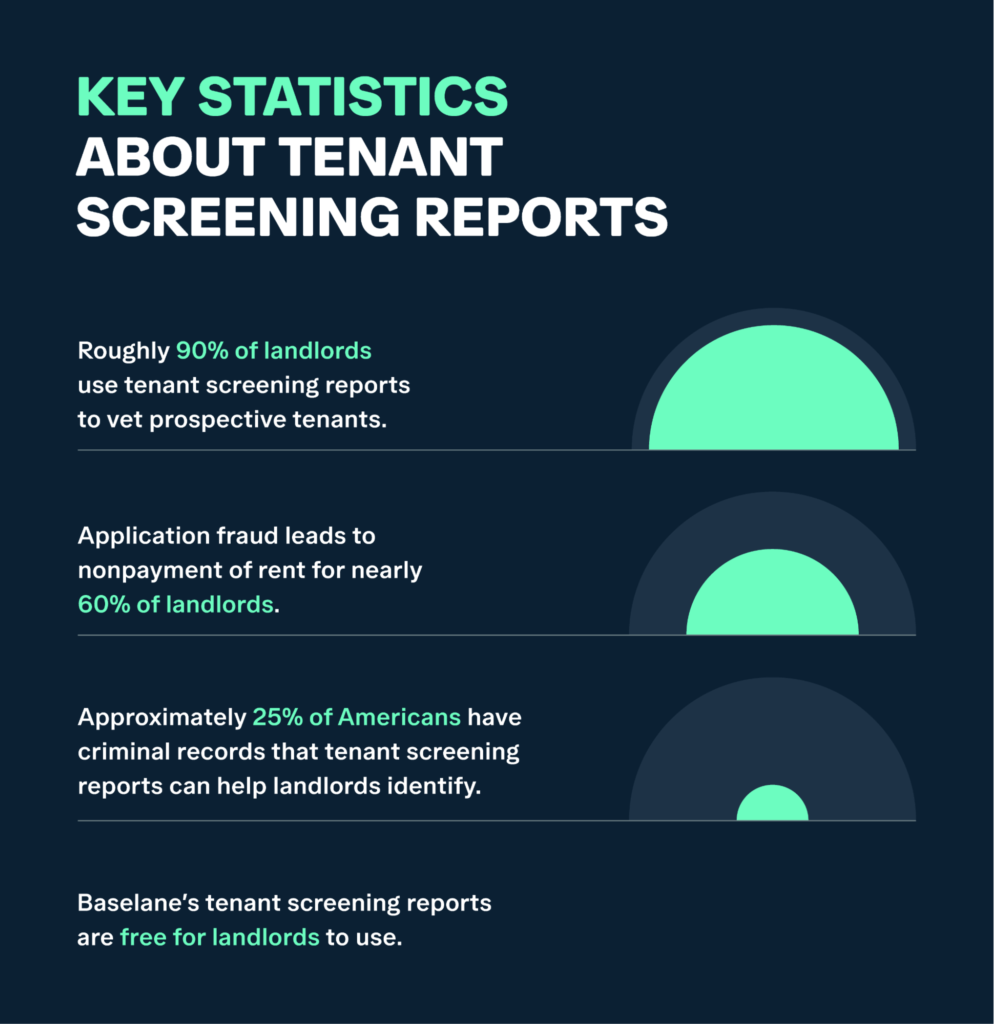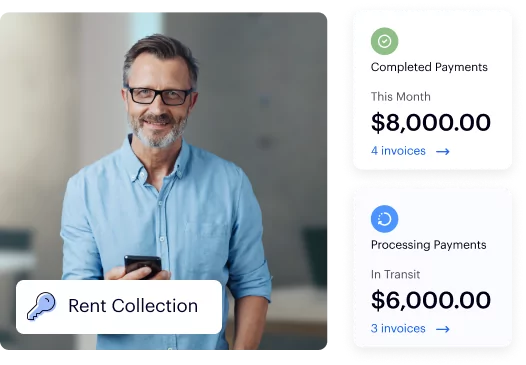Choosing the right tenant is one of the most important decisions you’ll make as a landlord. If you don’t have a standard tenant screening checklist or criteria, you could end up with bad rental tenants, leading to unpaid rent, property damage, or paying $3,500 or more for evictions.
One landlord in Malibu learned this the hard way. After skipping a background check, they ended up with a squatter who refused to leave, changed the locks, and manipulated tenancy laws—turning a simple rental into a legal nightmare. You risk financial losses and legal headaches without a solid tenant selection plan.
In this guide, we’ll share tenant selection criteria, covering credit scores, rental history, income verification, and fair housing laws.
Key takeaways:
- Set clear rules for income, credit score, and rental history to streamline decisions. Tenants should earn 3x the rent and have a credit score of 650+.
- Verify income using pay stubs (last two months), bank statements (last three months), or tax returns (for self-employed tenants) to confirm income stability and affordability. Request additional documentation if inconsistencies arise.
- Check credit scores and rental history, prioritizing tenants with no evictions.
- Use a tenant selection plan and criteria to ensure consistency and legal compliance, avoiding discrimination claims.
- Choose a reliable tenant screening service for comprehensive credit, background, and rental history checks.
What are tenant selection criteria?
Tenant selection criteria help landlords evaluate and choose reliable renters. Here’s what to consider when screening applicants:
- Rent-to-income ratio: Tenants should earn at least three times the rent to ensure affordability.
- Credit history: A 650+ credit score signals financial responsibility. Check on-time payments, low debt, and eviction-related collections.
- Rental history: Verify on-time payments, lease adherence, and eviction records to assess tenant reliability.
- Criminal background: Assess offense severity, time since conviction, and state laws when screening applicants.
Flexible vs. strict policies
- Flexible: Allows lower credit scores, past evictions, or minor offenses with conditions like a co-signer.
- Strict: Requires higher credit scores, no evictions, and no recent felony convictions.
How to use screening criteria for tenant selection
A structured tenant selection process ensures you choose reliable renters while staying fair and compliant. Here’s how to apply screening criteria:
Monthly income criteria
Rent affordability is key to ensuring on-time payments. In 2024, over 50% of renters paid over $1,500 monthly, while average rent hit $1,713. Meanwhile, renter incomes dropped from $53,100 to $52,600, increasing financial strain.
How to evaluate income:
- Follow the 3x rent rule: Most landlords require tenants to earn three times the rent amount. For a $2,000 unit, this means an income of at least $6,000 per month.
- Factor in debt obligations: Car loans, credit card debt, child support, and other financial commitments can impact a tenant’s ability to afford rent.
- Look beyond gross income: Net income (after taxes) provides a clearer picture of financial stability.
Income verification methods:
- Pay stubs (last two months): Look for a steady income and ensure it aligns with the tenant’s stated earnings. If a tenant’s recent pay stub shows irregular hours or fluctuating wages, ask for additional proof to confirm stability.
- Bank statements (past three months): Review deposits to ensure income is consistent and matches what’s reported. If a tenant claims to earn $5,000 per month but their bank deposits show inconsistent cash flow, it could be a red flag.
- Tax returns (for self-employed tenants:) A tenant’s IRS Form 1040 or Schedule C provides insight into their actual earnings. Self-employed tenants with high income but excessive business deductions may appear to have low taxable income—factor this in when assessing their financial strength.
- Employment verification letters: Request a letter from the employer confirming position, salary, and tenure. If a tenant recently changed jobs, ask whether they are still in their probationary period, as some employers have a 90-day termination policy for new hires.
Tip: Choose a screening service that verifies this information. In 2024, nearly 85% of landlords reported receiving fake pay stubs, employment references, and other income documents from rental applicants. Baselane verifies income through a tenant’s bank, payroll provider, or uploaded documents scanned using AI fraud detection software.
Employment criteria
Job stability shows a tenant’s ability to pay rent long-term. In 2024, the median employee tenure in the U.S. was 4.1 years, suggesting many renters may be relatively new to their jobs, which could impact income reliability.
How to evaluate employment:
- Job tenure: Has the tenant been with their employer for at least six months? Frequent job changes could indicate financial instability.
- Industry stability: Tenants in recession-proof fields (e.g., healthcare, government) often have more stable income.
- Income reliability: Salaried employees usually have more predictable pay than freelancers or commission-based workers.
Verification methods:
- Employment verification letters: Request a formal letter from the employer confirming job title, salary, and length of employment. If a tenant’s letter lacks company letterhead or contact details, follow up to verify authenticity.
- Recent pay stubs or tax returns: Compare reported earnings with official documents. If a tenant submits pay stubs but refuses to provide tax returns, they may be hiding additional income sources or financial instability.
- Direct confirmation from the employer: Call the employer’s HR department to confirm employment status. Be cautious if the listed phone number leads to a personal line instead of a company office.
Red flags:
- Frequent job changes without a valid reason: If a tenant has switched jobs every few months without career progression, they may struggle with stability, increasing the risk of missed rent payments.
- Unverified or inconsistent income sources: If a tenant claims high earnings but has no payroll history or business registration, they could misrepresent their financial situation.
- Self-employment without supporting financial documents: Self-employed tenants should provide tax returns, profit and loss statements, or bank records. If they only submit an informal invoice, it may indicate unreliable income.
Rental history criteria
A tenant’s rental history predicts their future behavior. A tenant who consistently pays on time is a lower risk than one with a perfect credit score but multiple past evictions.
Evictions are up 30% or more compared to pre-pandemic levels in cities across the U.S., making screening for past rental issues a non-negotiable.
| TOP 5 CITIES FOR EVICTION FILINGS | ||
|---|---|---|
| City | Filings | Relative to Pre-Covid Average |
| Minneapolis–Saint Paul, MN | 12,997 | +60% |
| Austin, TX | 13,161 | +43% |
| Gainesville, FL | 1,897 | +41% |
| Columbus, OH | 25,159 | +37% |
| Nashville, TN | 14,034 | +37% |
How to check rental history:
- Contact previous landlords for payment history and lease compliance.
- Use a tenant screening service to check for past evictions.
- Look for signs of lease violations, property damage, or landlord disputes.
What to ask previous landlords:
- Did the tenant pay rent on time every month?
- Were there any lease violations?
- Would you rent to them again?
Criminal background criteria
Over 90% of landlords run criminal background checks, but fair housing laws prevent blanket rejections based on past offenses. The U.S. Department of Housing and Urban Development (HUD) warns that overly strict policies can be discriminatory.
Here’s what to consider:
- Nature of the crime: Violent crimes and property-related offenses are more relevant than minor traffic violations.
- Recency: A crime committed 10+ years ago is less relevant than a recent offense.
- Rehabilitation efforts: Has the applicant maintained stable employment and housing since their conviction?
Key legal considerations:
- Ban-the-box laws: Some states, like California and New York, restrict when landlords can ask about criminal history.
- Reporting limits: Texas only allows landlords to consider offenses from the past seven years.
- Fair housing compliance: Blanket policies that exclude all applicants with criminal records can be discriminatory.
Note: Document specific offenses that would disqualify an applicant (e.g., violent felonies, property destruction) while ensuring compliance with local laws.

Tenant selection process: step-by-step guide
Here’s a step-by-step guide to selecting a financially responsible and reliable tenant while complying with fair housing laws.
Step 1: Define your criteria (income, credit score, references, etc.)
Before reviewing applications, set clear landlord-tenant selection criteria to simplify decision-making.
Key selection factors:
- Income requirements: Tenants should earn at least three times the monthly rent. A $1,800 unit means a minimum income of $5,400. In 2024, renters spent an average of 42% of their pre-tax income on housing, raising affordability concerns.
- Credit score: The average credit score was 717 in 2024. A score above 650 signals financial stability, while those below 600 may require a co-signer or higher security deposit.
- Rental history: No evictions or late payments in the past two years. Verified positive references from previous landlords.
- Criminal background: Focus on safety and property risk offenses, such as theft or violent crimes. Some states, like Texas, limit criminal background checks to the past seven years.
Step 2: Advertise the property transparently to attract qualified applicants
Wondering how to attract tenants? Posting on Zillow, Apartments.com, and Facebook Marketplace increases visibility, while clear criteria help screen out unqualified applicants from the start.
A well-crafted listing helps attract tenants who meet your tenant requirements list while deterring those who don’t.
What to include in your rental listing:
- Monthly rent and security deposit
- Minimum income and credit score requirements
- Pet policy (e.g., pet deposits, breed restrictions)
- Smoking policy (if applicable)
- Parking availability
- Utilities included vs. tenant-paid
Step 3: Pre-screen applicants to save time
A quick pre-screening process eliminates unsuitable candidates early, saving time on full background checks.
Tenant screening questions to ask:
- What is your monthly income?
- Do you meet the credit score requirement?
- Have you ever been evicted?
- Do you have pets? (If applicable)
- Are you willing to provide proof of income and rental history?
If applicants fail basic tenant selection criteria, politely decline early, avoiding unnecessary screening costs.
Step 4: Perform background and credit checks
What do landlords look for in a credit check and background check? Here’s how to use these reports for assessing financial and legal risks.
Credit check
Look for:
- On-time payment history: Frequent late payments indicate potential future rent issues.
- Debt-to-income ratio: High debt levels relative to income could signal financial instability.
- Public records: Bankruptcies, collections, or legal judgments can be red flags.
Background check
Look for:
- Eviction history: Evictions are up over 30% compared to pre-pandemic averages in major U.S. cities, including Phoenix, Houston, and Nashville, highlighting the need for thorough vetting.
- Criminal record: California, Washington, and Oregon have “Ban the Box” laws, which prevent landlords from checking a tenant’s criminal history until after a conditional lease offer. Seattle and Oakland have stricter ordinances that prohibit most landlords from conducting criminal background checks at any stage of the rental process.
- Pending charges: Some screenings display pending cases; however, landlords must evaluate them carefully.
Step 5: Verify employment and rental history
Always verify an applicant’s job status and past rental behavior to confirm their ability to pay rent consistently and follow lease terms.
Employment verification methods
- Pay stubs (past two months): Confirms stable income.
- Tax returns: Required for self-employed tenants.
- Direct employer confirmation: Ensures the job is legitimate.
Rental history verification
- Past landlords confirm rent was paid on time.
- No lease violations, property damage, or excessive complaints.
- Eviction data reveals whether a tenant poses a risk.
Step 6: Compare applications and identify red flags
After screening applicants, compare them based on the tenant selection checklist to choose the ideal tenant.
Prioritize tenants who:
- Have a stable income that meets or exceeds 3x the rent
- Have a strong rental history with no evictions or major lease violations
- Show responsible credit behavior, even if their score isn’t perfect
- Have long-term job stability in a reliable industry
Warning signs to watch for:
- Rent-to-income ratio above 40%: According to Zillow, the median U.S. rent-to-income ratio reached 30% in 2024, making income verification a top priority. If a tenant spends more than 30% of their income on rent, they may struggle with payments.
- Multiple late rent payments or evictions: A history of non-payment is a red flag.
- Inconsistent job history: Frequent changes without career progression suggest financial instability.
Tip: If two tenants qualify, prioritize the one with a proven rental history over a high credit score. Consider long-term tenancy potential—tenants who plan to stay longer reduce turnover costs.
Step 7: Finalize the decision and offer the lease agreement
Once you’ve chosen a financially responsible tenant, follow proper legal procedures for lease approval and rejection.
If approving a tenant:
- Provide a lease agreement outlining rent terms, policies, and responsibilities.
- Collect the security deposit and first month’s rent before move-in.
- Set clear expectations regarding property rules and payment methods.
If rejecting a tenant:
In 2024, over 200 landlords in California were fined for illegally rejecting Section 8 tenants, underscoring the importance of fair and legal rejection procedures.
- Ensure compliance with Fair Housing Act regulations: Rejections must be based on objective factors, not personal reasons. The Fair Housing Act prohibits discrimination based on race, color, religion, sex, disability, familial status, or national origin.
- Provide written notice if required: Under the Fair Credit Reporting Act (FCRA), if a landlord denies an application based on information from a tenant screening report, they must provide the applicant with an adverse action notice. This notice informs the applicant of the decision and their rights under the FCRA.
- Keep screening records for compliance: Keeping thorough records of the screening process, including applicant information, screening criteria, and reasons for denial, can protect landlords from discrimination claims and demonstrate compliance with fair housing laws.
Sample tenant selection plan
Use a standard tenant selection plan to screen applicants fairly. Here’s what to include:
- Clearly defined screening criteria: Outline specific requirements for income (e.g., 3x monthly rent), credit score minimums, and acceptable rental history.
- Fair housing compliance measures: Ensure selection policies and criteria follow federal, state, and local fair housing laws to prevent discrimination.
- Standardized application requirements: Use a consistent application form and process for all applicants to maintain fairness and legal compliance.
- Transparent decision-making process: Clearly explain how applications are evaluated, including the weight credit, income, background, and references have on the selection of tenants.
Steps for approval or denial notification: Include timelines and procedures for notifying applicants of the outcome and provide reasons for denial when required by law.
Comprehensive documentation procedures: Keep detailed records of applications, communications, screening results, and final decisions for legal protection and consistency.
Find great tenants and manage your rentals all in one place with Baselane
One bad tenant can cost thousands in lost rent and legal fees. Baselane’s tenant screening service delivers comprehensive credit and background checks, bank-verified income, and eviction history, delivered in minutes for free —so you can find reliable renters quickly and hand over the key with confidence.
Plus, you can collect rent and deposits, open security deposit accounts, e-sign leases, schedule maintenance, and automate your rental accounting (plus more) to manage the entire rental process all in one place.
Ready to find your next great tenant? Start screening for free today.
FAQs
Compare tenants based on income, credit score, rental history, and background checks. A stable income—typically three times the rent—shows financial reliability. A credit score of 650+ is ideal, but payment history matters just as much.
Rental history confirms if a tenant pays on time and follows lease terms. Background checks help identify risks but must comply with legal guidelines. If two tenants are equally qualified, factors like lease length or move-in readiness can help you decide.
The basis for determining whether to accept or reject risk includes a tenant’s financial stability, rental history, and background check. If income is too low, debt is high, or past evictions exist, landlords may see them as risky. A low credit score alone isn’t always a dealbreaker, but unpaid debts and missed payments raise concerns. Criminal records are assessed based on severity and relevance to tenant safety. If a tenant doesn’t fully meet the criteria but has a strong co-signer or offers a higher deposit, landlords or property managers may reconsider.
52% of landlords use multi-factor screening beyond traditional credit checks, ensuring they choose tenants who are financially responsible and reliable.
To reduce risk and ensure good tenant selection, follow these steps:
- Use professional screening tools: 45% of landlords use advanced screening technologies, like Baselane’s tenant screening service providing detailed reports on credit, background, income, and eviction history.
- Prioritize rental history over income: A tenant with a record of on-time payments and positive landlord references is more reliable than someone with a high income but no rental experience.
- Look for long-term tenants: 92.5% of renters stay in one place for at least two years, reducing vacancy risks.
- Ensure fair and consistent screening: Follow the same criteria for all applicants to comply with fair housing laws and avoid discrimination claims.
A tenant selection policy sets landlords' legal and screening criteria to evaluate applicants, including income, credit score, rental history, and background checks. It ensures compliance with fair housing laws and prevents discrimination.
A tenant selection plan is a step-by-step document that outlines how landlords apply these criteria. It acts as a checklist, helping landlords screen tenants consistently and efficiently.
If you're wondering how do landlords pick tenants, a tenant selection criteria form is a key tool in the process. It outlines income requirements, credit history, rental history, and background checks to ensure a consistent and fair screening process. This helps landlords comply with fair housing laws, attract qualified tenants, and minimize rental risks. A structured form also protects against discrimination claims.
As a landlord, you check rental history by contacting previous landlords, reviewing public records, and using tenant screening reports. Look for on-time payments, lease violations, and past evictions. Many landlords use third-party screening services for a detailed background check. Verifying rental history helps reduce late payments, property damage, and lease disputes.
When you run a credit check on a tenant, you’re looking for signs of financial responsibility. Landlords review credit scores, payment history, outstanding debts, and any bankruptcies or collections. A strong credit report suggests a tenant will likely pay rent on time. Some landlords may accept lower credit scores if the applicant has a solid rental history or a co-signer.
A written tenant selection plan template helps landlords create a standardized screening process that ensures fair and legal tenant evaluations. It provides a clear structure for assessing applicants based on objective criteria like income, credit, and rental history.
Using a template minimizes the risk of bias or discrimination and ensures compliance with housing laws. It also speeds up the tenant selection process, making it more efficient. A well-documented plan protects landlords from disputes and legal challenges.
They are not the same. Tenant selection criteria refer to the specific standards landlords use to evaluate applicants, such as income, credit score, rental history, and background checks. A tenant selection agreement is a formal document outlining the screening process, ensuring consistency and compliance with fair housing laws. While the criteria help determine who qualifies, the agreement ensures transparency and protects both landlords and applicants.
Tenant screening criteria are the specific requirements landlords use to evaluate applicants, such as minimum credit score, income-to-rent ratio, eviction history, and background checks. These criteria help filter out high-risk tenants before moving forward in the rental process.
Tenant selection criteria go a step further by outlining the entire decision-making process, including how applications are reviewed, how tenants are ranked, and how final approvals or rejections are handled. This ensures a structured and legally compliant approach to choosing tenants.









